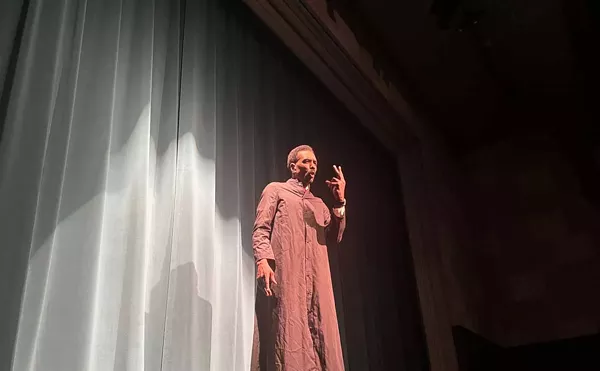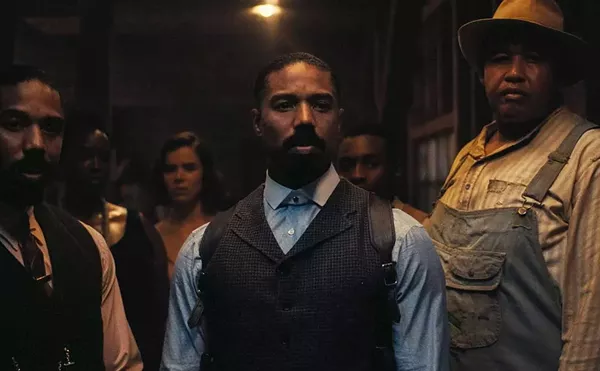
Audio By Carbonatix
[
{
"name": "GPT - Leaderboard - Inline - Content",
"component": "35519556",
"insertPoint": "5th",
"startingPoint": "3",
"requiredCountToDisplay": "3",
"maxInsertions": 100,
"adList": [
{
"adPreset": "LeaderboardInline"
}
]
}
]
The vintage apartment building at the corner of Hancock and Second Avenue has many stories to tell. The Renaud, which faces Wayne State University's Elaine L. Jacob Gallery, is one of an infamous complex of apartments, abandoned buildings and warehouses where — from the socially and politically volatile '60s into the '90s — a family of artists, poets and musicians lived, loved, talked, made their art and, sometimes, died.
As it turns out, many artists whose work is featured in Time and Place: Art of Detroit's Cass Corridor from the Wayne State University Collection — the current exhibition at the Jacob Gallery — lived in the Renaud for years. Some still live there.
Time and Place is a beautifully curated and installed exhibition of Cass Corridor artists from approximately 1968 to 1980, mainly from the collection of iconic patron and infamously eccentric aesthete James Pearson Duffy. By no means is the showcase encyclopedically representative of the cast of artists who haunted the Corridor. Nor is it meant to be. Time and Place is a tribute to Mr. Duffy, who roamed the streets of the city, often photographing Detroit's vernacular architecture, frequenting museum and gallery openings, and befriending and patronizing artists and art galleries alike.
These days, with the help of his aide, Duffy still makes his rounds of galleries. Time and Place commemorates Duffy's gift of his art collection, and of a substantial endowment to the university to maintain it, and celebrates the naming of the institution's art department after him: Wayne State University's James Pearson Duffy Department of Art and Art History.
It's essential to point out that there were many fine artists then and there who Duffy didn't collect. Many would howl at the notion that Duffy somehow defined the aesthetics of the moment, though probably most would've loved to receive his patronage.
Duffy typically collected raw-edged, unrefined abstract works that were often composed of salvaged or appropriated materials. (Wayne State University's art collection, of course, includes many Corridor artists whom Duffy didn't collect, and some works included in the exhibition don't typify the moment.)
Very few works from Duffy's fall flat or fail to contribute to an understanding of the time and place in which they were created. In an engaging documentary included, Images from Detroit's Cass Corridor — made from original footage by Corridor artists Kathryn Brackett Luchs and Shaun Bangert — artist John Egner said that they didn't set out to make a movement or "style." He elaborated that the artists happened to be working together at the same time in the same community and, essentially, wound up in a dialogue about art and culture. They supported one another, but worked separately. Egner was being modest, underplaying the political and social significance of the day. He knew, as all the smart artists knew, that they were involved in a rare moment and that they had a common goal of engaging that moment with near-frightening passion.
There's a piece of grainy Super 8 footage in the doc of Michael Luchs, a quintessential Corridor artist. He's wrestling with his own painting that, in order to achieve a certain texture perhaps, he'd set on fire. As stereotyped as the famous images of Pollock making his drip paintings, this Promethean sight of Luchs with fire exemplifies the time. There were big issues at stake and each artist engaged the moment on their own terms.
During these formative years, few artists had done their best work, so there's an unevenness in this exhibition that some will recognize immediately. But the spread of work is so vast that we understand the staggering experimentation with material and genre that took place. A John Egner lattice piece, "Doug's Smoke," nails the brilliance of his constructivist act of gridding the ineffable and grasping the intangible. Egner constructed a gorgeously patinated wooden "drawing" of the smoke coming off Doug James' joint.
Because many artists then were too shy or silent, Egner, who was a painting professor at Wayne State for many years, was, by default, the Corridor's unacknowledged spokesman.
It's enlightening to listen to both Ellen Phelan's and Nancy Mitchnick's articulate descriptions of their roles as artists and women, and their views of the history of the Cass Corridor, as Brackett captured them on film and tape. Both women abandoned Detroit quite early for New York and continue to have brilliant careers as artists. Fortunately, Duffy collected both.
Mitchnick's large-scale "Portrait of James F. Duffy, Jr." captures the man's timidity well; it's a natural centerpiece of the exhibition. Phelan's flat chair wrapped in torn strips of canvas, "Untitled (Chair), 1971-72," is a delightfully "useless object," as she termed it, that, on top of challenging differences between painting and sculpture, suggests philosophical differences between idea and reality. In retrospect, many of the Corridor artists made objects. Perhaps because of the scary uncertainty of the time that tested or suggested the flimsy foundation of the reality.
Both of Doug James' "Paint on Cardboard Constructions," while witty cartoonistic depictions of the mundane world — one a frying pan on a funky cook top and the other, "Room 319," a derelict hotel room — also suggest philosophical uncertainty or a conflict between fact and fantasy.
There's also Gordon Newton's notable "Untitled Pair," which typifies much of the expressionist and essentialist vitality of the time. Two long planks of "found" wood that have been cut by circular saw, stand together, like an abstraction of Grant Wood's "American Gothic," as if they were a demure couple lacerated by time. In the film, Egner says that Newton's seemingly aged, salvaged-looking materials were actually new and that he "built" the aged look into the work. A few artists, including Robert Sestok and Paul Schwarz, employed the circular saw, the metal grinder, among other crude tools of industry, to draw with.
On any given night, art gave way to drinking and talking. On one humorously memorable 1975 night at the Bronx Bar, a frequent haunt of Renaud residents, painter Jim Chatelain mused, "You draw with whatever you have," and then he pointed to the bartender-owner who was, as usual, mopping the floor like an abstract expressionist painter signifying "last call." Before that, in '73, Brackett Luchs captured Sestok chopping at a log with a hand ax in consort with sculptor John Piet "playing" a metal grinder, radiating a pyrotechnic display of sparks, to pound out a rhythm for a performance piece with recently deceased painter David Snow and Keith Schiller.
The stories and myths about the Corridor continue to collect, but, looking back at the moment (perhaps with some nostalgia), everyone was, and is, bigger than life. Among them one remembers brilliant thinkers and leaders, inventive and powerful creators, egoists who dominated and followers who mimicked. There were the shy and recalcitrant, and they were all young and growing up in very troubled times in a troubled city, let alone country. There was racial apocalypse on Detroit streets, and the horrors of Vietnam divided the country. There was sexual exploration and the last gasp of acceptable male machismo. There were the political idealists and the anarchists. Alcohol, marijuana and psychedelic drugs were prevalent too. And if one looks carefully, the art in Time and Place vaguely suggests the reality behind the work but it is there worth exploring. It was wonderful and it was awful.
Time and Place: Art of Detroit's Cass Corridor from the Wayne State University Collection runs thru June 26, at the Elaine L. Jacob Gallery, 480 W. Hancock, Detroit; 313-993-7813.





